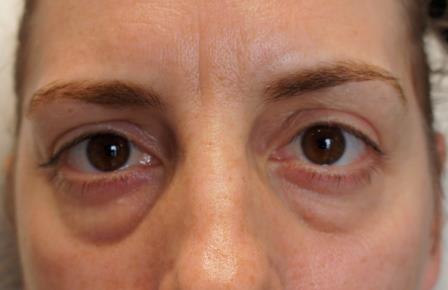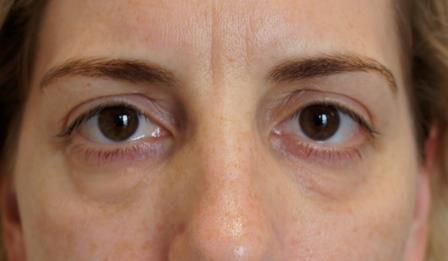With Cosmetex just around the corner, here is a sneak peek of the talk “Blood, Sweat and Tear Troughs,” which Dr Ron Feiner and Dr Naomi McCullum will be presenting on Saturday 20 April.

Many patients express concern about the impression of a somewhat gaunt appearance consequent to their tear trough hollowing. A tear trough deformity can be one of the most difficult regions to correct either surgically or non-surgically. Patient disappointment and disaffection is common in parallel with physician despair.
To define it, a tear trough (also known as naso-jugal groove) is often a natural anatomical demarcation below the eyes, extending for up to 3cm infero-laterally from the medial canthus. When appreciably deep it appears as a component of midface deformity and can significantly contribute to general midface aesthetic insufficiency. Extending laterally from the tear trough is the lid/cheek junction.
Plastic surgeon Michael Kane (Kane MA. Treatment of tear trough deformity and lower lid bowing with injectable hyaluronic acid. Aesthetic Plast Surg. 2005;29:363–7) provided an excellent description of the tear trough as a depression centered over the medial inferior orbital rim and bounded superiorly by the infraorbital fat protuberance. The inferior border of the tear trough is formed by the thick skin of the upper cheek with its abundant subcutaneous fat, suborbicularis occuli fat and portions of the malar fat pad. In most individuals, the trough is deeper medially, becoming shallower laterally. The thin skin at the depth of this groove has very little fat beneath it, contributing to the apparent depression. With age, further loss of soft tissue and, importantly, a loss of osseous support also causes the tear trough to deepen further.


These pictures show a patient’s before and after appearance, following just one tear trough treatment
An appealing lid cheek “continuum” is desirable and complies with the facial aesthetic rule of beautiful facial ogee curves (i.e. continuous facial “S” curves).
It is also very important to appreciate the dynamics of lower eyelid function when injecting this region. There is an obvious difference between subcutaneous lid fat on the lower eyelid and the cheek. As opposed to cheek fat, subcutaneous fat covering the lid must be very thin so the lid can move easily in normal ocular function. A subtle demarcation between the lid and the cheek is natural but can become unaesthetic when deep.
Although frequently considered a simple facial depression to treat, a tear trough is in fact a complex and often poorly understood target for many cosmetic injectors. The objective of an aesthetic improvement in the area can be complicated by persistent nodularity and oedema that can prove resistant to correction. Bruising and skin discolouration frequently further complicate matters. These complications are unsightly, distressing and can interfere with normal eyelid function.
Perhaps the most serious potential complication when injecting fillers in the peri-orbital region is the risk of intra-vascular injection with consequent skin damage or even blindness (Nicolau syndrome or embolia cutis medicamentosa). Branches of the facial artery/vein in both the nasolabial fold and the medial aspect of the tear trough are far more vulnerable than commonly appreciated.
Concerned by the number of tear trough injection complications presenting to their clinics, Drs. Ron Feiner and Naomi McCullum decided to submit a paper at Cosmetex 2013 aptly titled ‘Blood, Sweat and Tear Troughs- what is it, where is it and how should we actually be injecting it?’
“We present an original and unsponsored paper that outlines the anatomy of the tear trough and why complications are common with cosmetic injections in this region,” says Feiner.
Established injection techniques for treatment of tear trough deformity are explored in their presentation and some novel treatment approaches are suggested. For instance the importance of not only treating the tear trough deformity but the whole malar complex is emphasised when this region is generally deficient. However each patient presentation demands a bespoke approach.
Photographs from the presenters’ own cases that demonstrate both pleasing treatment outcomes and complications accompany the presentation.
Visit www.cosmetex.org/melbourne2013 for further information.

